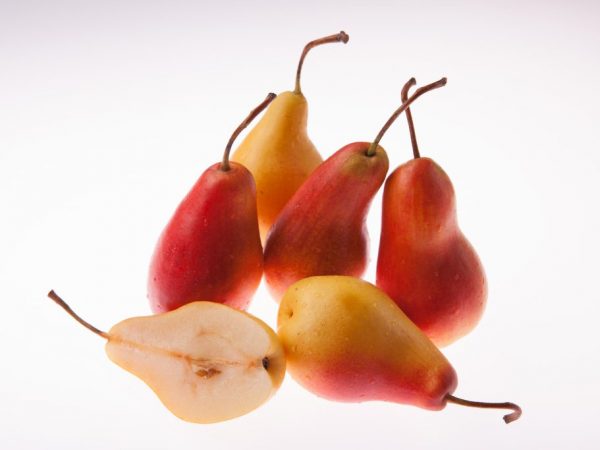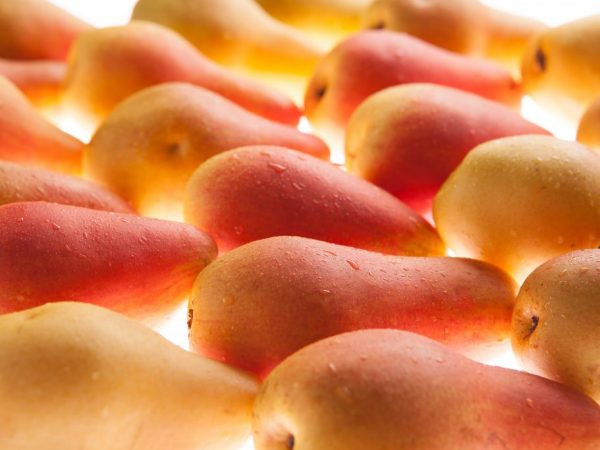Description of pear variety Zabava
Pear Zabava is a high-yielding variety. Withstands temperature changes and grows well even in adverse conditions.

Description of pear variety Zabava
Characteristics of the variety
Fun is an autumn pear variety. If you create the right conditions, then up to 100 kg of the crop can be harvested from an adult tree.
Medium frost-resistant variety takes root in sandy and clayey soils. It does not differ in tall trees: in the first 2 years, the culture reaches its maximum height, and then grows with lateral shoots.
The pear Zabava begins to bear fruit for 5-6 years. The yield increases gradually, over the course of 2-3 years. All this time, the tree needs regular maintenance. Mature trees bear abundant fruit. The variety is pollinated by neighboring horticultural crops.
Description of the tree
The Zabava trees have a lush pyramidal crown. The leafiness of the tree is medium. The older the tree, the larger the foliage. The leaves are medium to large in size, dark green in color. General description of the tree:
- thick trunk with scaly bark;
- lateral shoots of medium length and moderately thick, they grow at right angles to the trunk;
- ovaries and fruits are formed on ringed shoots.
Description of the fetus
Pear Fun grows to a medium size - no more than 160 g. Fruits are of the correct rounded shape. The pear skin is rough, slightly dry and with dark spots. As soon as the fruits ripen, the peel turns from green to honey-yellow. A brownish tint appears before harvest.
The subcutaneous points of the pear are well pronounced, their color is gray-yellow. The pulp has an average density and a pleasant sweetish taste. The pulp is juicy white with small veins that do not affect the taste. The pear rarely cracks due to its dense rind, even if it is idle for a long time.
Growing pears
Growing conditions
Loose soil with moderate moisture in autumn and spring is suitable for the variety. Rainy regions are not suitable for pear cultivation, as the fruits lose their taste and become watery. A soil is selected that allows air to pass through well (a small amount of clay). A well-lit area with minimal drafts is selected for the variety.
Landing in the soil
The variety is planted in autumn or early spring. Pits are preliminarily prepared for planting with a good layer of fertilizer and fertile soil. The top layer of soil from the pit is mixed with organic fertilizers (compost or manure is used). Potash fertilizers are introduced, which will nourish the rhizome in the early years. Additionally, nitrogen fertilizers or lime are introduced into the planting pit if the soil is acidic.
A peg is driven into the center of the pit. It should become a support for a young seedling. If the planting hole is prepared 2-3 weeks before planting (the soil should settle), then the seedling is soaked in a special solution 10-12 hours before planting. The root system is immersed and carefully covered with soil residues. The seedling is abundantly watered with purified water.
Plant care

Fertilize your plant for a good harvest
Grushe Zabava needs standard care. For the winter, the seedling needs to be covered (use fertilizer or compost). Watering is carried out in the warm season, as the soil dries out. There is no need to water the tree in winter: watering resumes in early spring.
Additional watering is needed after applying mineral fertilizers. The soil is fully fertilized once every 2 months, if the tree grows and lets out young shoots. Organic fertilizers are applied from the third year of active growth, and only once a year.
The tree is pruned in early spring before the first buds appear. The cut site is treated with a disinfectant solution. If the tree is sick, watering is stopped and additional fertilization is applied.
Pear diseases
Fun suffers from common diseases of horticultural crops. Scab appears on inflorescences, then on foliage and fruits due to the marsupial fungus. The disease develops in early spring, when the pear is weakened after winter. Rot threatens the fruit tree: rot circles appear on pears, which cause the fruit to deteriorate quickly.
Dangerous for pears is a sooty fungus. The first signs of the disease are black bloom on the leaves and fruits.
Fight disease
To prevent diseases in early spring, prevention is carried out. The pear is sprayed with Bordeaux liquid.
To combat scab, a mixture of lime, copper sulfate and water is used. The whole tree and neighboring crops are processed so that the disease does not spread. Fruit rot is treated with chemical treatment. Copper oxychloride helps to get rid of fungal diseases at any stage.
Modern preparations Hom or Topaz help to cope with the sooty fungus. To prevent the spread of the disease, in the fall, trees are necessarily pruned and rejuvenated (the crown is thinned out).
Conclusion
Pear Zabava is a beautiful tree with a lush crown and delicious fruits. Minimal care is required. Watering, fertilizing the soil and pruning on time will improve the quality of the crop. Pear trees rarely get sick, and treatment with special means saves them from fungi.


